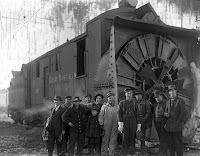 This week’s snowy weather in Western Washington reminds me how all-weather travel is really a modern convenience. In the early days of the transcontinental railroads, winter line closures were a frequent occurrence. The introduction of the rotary snowplow improved winter operating conditions for railroads, particularly in mountain passes here in Washington, but also notably in California and British Columbia.
This week’s snowy weather in Western Washington reminds me how all-weather travel is really a modern convenience. In the early days of the transcontinental railroads, winter line closures were a frequent occurrence. The introduction of the rotary snowplow improved winter operating conditions for railroads, particularly in mountain passes here in Washington, but also notably in California and British Columbia.
In this region, the Great Northern Railway, Northern Pacific Railway, and the Canadian Pacific Railway relied on rotaries to clear heavy snow. Accounts of the 1910 Wellington Disaster frequently mention the efforts of rotaries to keep Stevens Pass open, and it was only a shortage of coal that prevented them from continuing to clear snow. (X808 was one of those rotaries and is pictured here circa 1913.) Considered the “big guns” of snow clearing, rotaries continued to play a prominent role in winter railroading until well into modern times.
So what is a rotary snowplow? It is a giant wheel of cutting blades that spins into the snow, shaves off a layer of snow and then expels it to the side of the tracks. The plow itself is not self-propelled – one or more locomotives push it. Traditionally, blades were steam powered. Today the few rotaries remaining in service are diesel-electric.
Toronto, Canada Dentist J.W. Elliot invented the rotary snowplow in 1869 but a practical application was not tested until Leslie Bros. built Orange Jull’s design in 1883. Other manufacturers including Cooke soon manufactured variations on the concept.
The Northwest Railway Museum owns former Northern Pacific Railway steam rotary snowplow #10. Built in 1907, the plow was used extensively on Stampede Pass, a mountain pass used by the Northern Pacific just east of Auburn and a little south of the better-known Snoqualmie Pass. Retired in 1964 and donated to the Museum, rotary 10 can be viewed at the Snoqualmie Depot.

